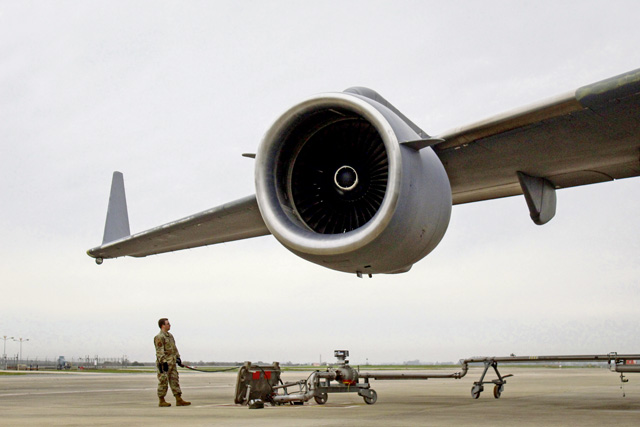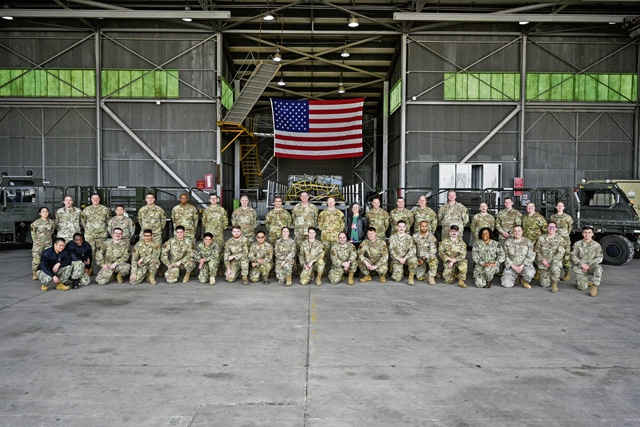
The 725th Air Mobility Squadron executed their continuity of operations plan from Naval Station Rota, Spain, to Morón Air Base, Spain, as a part of Exercise Rising Phoenix from Feb. 5-9. The exercise simulated a natural disaster and was meant to assess and demonstrate the joint effort between the 725 AMS, NAVSTA Rota and the 496th Air Base Squadron at Morón Air Base, surging to 24/7 operations to support enroute Air Mobility Command aircraft heading downrange.
Featuring 88 U.S. Air Force and U.S. Navy personnel from various career fields and rates, Exercise Rising Phoenix demonstrated the two installations’ ability to work together, maneuvering mobility forces and equipment across the Iberian Peninsula via ground assets. The 725 AMS accomplished this by exercising their ability to disaggregate and re-aggregate at an alternate airfield with support from 496 ABS and NAVSTA Rota personnel.
Personnel from the 725 AMS were tasked with performing 24-hour maintenance, supply, and air mobility command and control functions, while the 496 ABS performed aerial port, ground transportation, airfield operations, fuels management, cyber operations, sustainment services, and reception functions. NAVSTA Rota provided four air transportation specialists to imbed with the 496 ABS, improving host-installation communications and planning with the teams at NAVSTA Rota.
During the weeklong exercise, the joint force supported 12 AMC missions, ferrying 290k lbs. of cargo, 89 passengers and 42 aircrew to accomplish 97 percent of their desired learning objectives. The 725 AMS leveraged ‘Starshield,’ the DoD-contracted version of SpaceX’s ‘Starlink,’ to establish a satellite connection and provide flightline Wi-Fi access, demonstrating the technology’s utility for continuity of operations.
“I could not be more proud of our teams for cultivating the combined, joint, interagency, host nation, and intra-Service partnerships necessary to ensure that critical missions like AMC’s Global Air Mobility Support System can continue anytime and anywhere,” shared Lt. Col. Christopher Curry, 496 ABS and U.S. Forces Morón commander, while echoing senior leaders’ praise. “Watching our 725 AMS and 496 ABS Senior Non-Commissioned Officers and Company Grade Officers showcase mission command was a sight to see. They took intent, trust, and empowerment to execution with exceptional initiative and minimal oversight, proving that the global gateway is ready to take on any challenge.”
The teams also demonstrated Over the Horizon Augmentation technology — HoloLens II augmented reality headsets. HoloLens is a wearable headset that allows multiple users to be shown and share an augmented reality. Pairing it with Starshield technology, the headsets can be used to connect deployed forces with off-site personnel to assist with issues they are experiencing in the field. HoloLens allows users to interact virtually with subject matter experts to troubleshoot complications and facilitate swift resolutions to complex issues that could hinder Rapid Global Mobility.
This technology can potentially reduce or even eliminate the need to deploy additional personnel for mission continuation in the future — a glimpse into the future of GAMSS command, control and connectivity communications and capabilities.
“The 725 AMS has ambitious goals to get after the USAF Expeditionary Center’s 2024 campaign plan for GAMSS forces,” shared Lt. Col. Brian Shea, 725 AMS commander. “This first iteration of Exercise Rising Phoenix marks a significant investment in the development of our CGOs and SNCOs. Watching our team collaborate seamlessly with our Spanish allies, U.S. Navy and the 496 ABS to shift airflow between our operating locations was truly inspiring. Thank you to all our partners whose contributions made this achievement possible and are excited to grow our partnerships in future exercises and operations.”
Additionally, Exercise Rising Phoenix exposed CGO’s and SNCO’s to the hurdles associated with supporting disaggregation and reaggregation operations at an alternate airfield. The exercise was the perfect opportunity for tactical leaders to refine their Joint Planning Process principles in a controlled environment.
“What was so incredible about our first iteration of Rising Phoenix was seeing how successful grass root efforts can be,” shared Capt. Rebecca Roach, 725th AMS Detachment 1 commander, I am beyond proud to have been a part of the team that made this happen and cannot wait to see how future iterations of this exercise unfold.
On Feb. 7, members from the 725 AMS and 496 ABS hosted distinguished visitors from both AMC and U.S. Air Forces in Europe – Air Force Africa to demonstrate the highlights of Exercise Rising Phoenix.
The day began with an overview briefing of the exercise, highlighting the exercise’s goals and objectives. The DVs then visited with key members of the exercise, toured a C-17 Globemaster III and more.
During the visit, HoloLens and Starshield technology was presented by Senior Master Sgt. Anthony Sewejkis, 725 AMS maintenance superintendent, and operated by Staff Sgt. Juan Castaneda-Bedolla, a 725 AMS client systems technician. They demonstrated the tools by having one user build a mock aircraft model while receiving guidance from the other user with the manual in a separate location. Additionally, the DVs in attendance were able to try on the HoloLens headsets and experience the practicality of the tool themselves. This capability is a glimpse into the future of GAMSS GC3 communications and capabilities.
Exercise Rising Phoenix demonstrated joint interoperability and multi-capability. Executing a successful COOP and refining expertise provided United States European Command forces with valuable lessons learned and helped establish the tactics, tools, and procedures for future operations.



